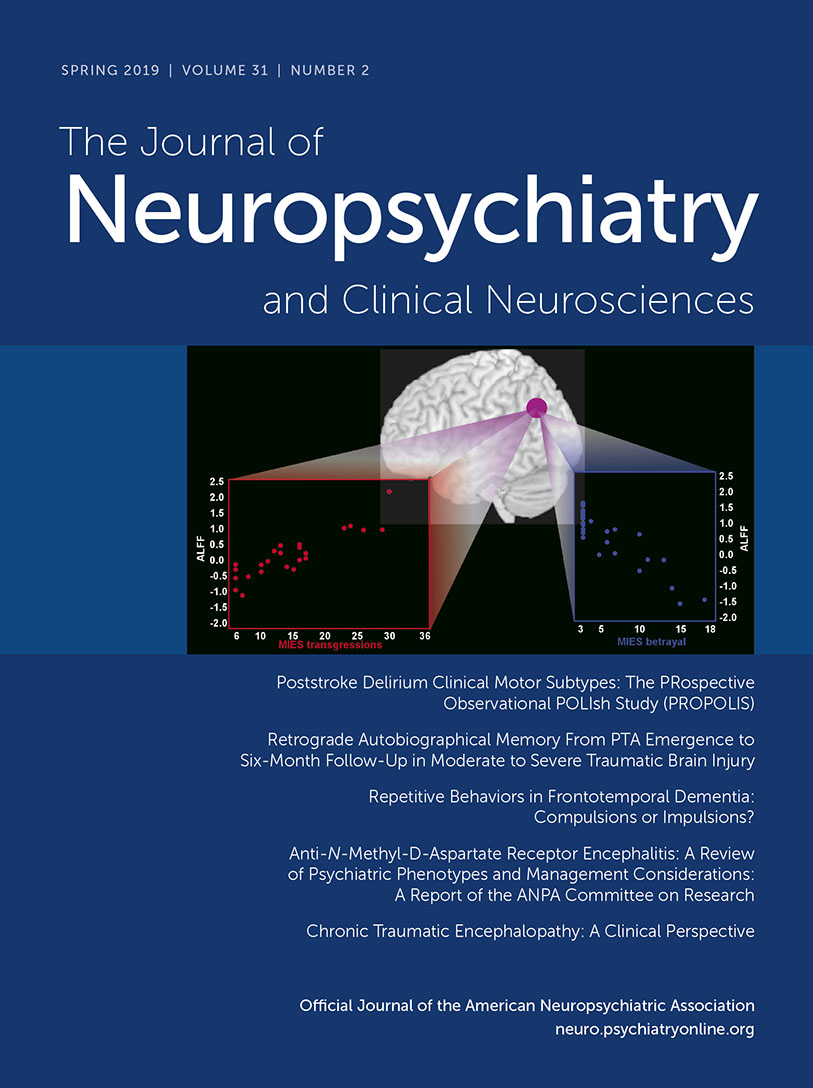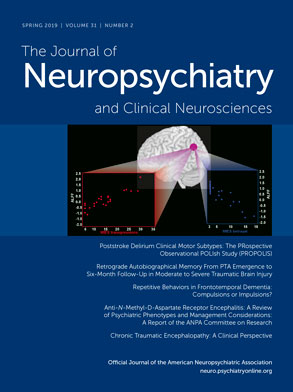The concept of chronic traumatic encephalopathy (CTE) has dramatically altered neuroscientific thinking about potential relationships between traumatic brain injury (TBI) and dementia, two of the more prevalent health challenges facing medicine and society. Whereas these disorders both feature cognitive impairment, a plausible link between them was relatively obscure until the past decade, when widely publicized neuropathological data began to appear describing a dementia syndrome in people who had been exposed to repetitive mild TBI (mTBI) (
1). This condition was noted to feature prominent cerebral tauopathy and was referred to as CTE (
1). The term CTE had actually been first proposed in the 1940s (
2,
3) but garnered little attention outside of medical professionals whose work focused primarily on sports and TBI. In contrast, the reintroduction of the idea immediately attracted the attention of a wide range of medical professionals and at the same time generated significant health concerns among the general public. This phenomenon has in large part been related to media coverage regarding a poorly operationalized cluster of symptoms and outcomes that were hypothesized to be related to cerebral tauopathy identified in brains of former professional athletes. In turn, this sense of alarm has led many individuals with repetitive mTBI from a variety of exposure settings to suspect that they have CTE because of symptoms similar to those of people who were later found to have the condition at autopsy. Some people may even suspect that they have CTE after a single mTBI. Such individuals may be markedly distressed by their self-diagnosis, or by having had this diagnosis suggested by a medical professional. In turn, they frequently turn to clinicians, seeking validation for their suffering while at the same time expressing concerns that they have an incurable disease. Facing this dilemma, those who care for these individuals would be well advised to step back and consider the phenomenon of CTE from a broad evidence-based perspective that maintains the patient’s well-being as the foremost priority.
A fact about which all agree is the existence of a neuropathological entity that has been termed CTE, although postmortem criteria are not always consistently defined. Autopsy has provided key information about tauopathy and other brain changes observed after multiple mTBIs in athletes and military veterans, leading to energetic investigation of what appears to be a disease similar or identical to the older entity described in retired boxers known as dementia pugilistica (
4). The essential point for clinicians, however, is that no method exists for making the diagnosis of CTE during life. Brain biopsy could potentially disclose neuropathological features of CTE but is prohibitively hazardous as a procedure given that no effective treatment to modify the presumed neuropathology is available. Clinical criteria have been proposed, but despite much investigation, no such criteria have been agreed upon for identifying CTE in living patients who may be at risk (
5,
6). Similarly, while efforts to visualize the accumulation of tau in the living brain using positron emission tomography have yielded some useful information (
7), as of this writing, no neuroimaging technique can be used to confirm that CTE actually exists in a person with worrisome symptoms and exposure to repetitive mTBI (
8). What then is a clinician to do?
One unresolved issue is that the clinical features thought to be associated with CTE have varied over time. Speech, movement, and memory disturbances were historically reported in autopsy-identified cases of dementia pugilistica, but alterations in personality and emotional expression, along with cognitive decline, have been the clinical focus of CTE cases (
8). The literature has not yet provided an explanation that reconciles these varying clinical manifestations, although a neuropsychiatric perspective has likely added more detail to the clinical profile of recent cases. Whereas dementia pugilistica and CTE share enough clinical pathological features to invite the notion that they are the same disease, it is not yet firmly established that the disorder linked to boxing several decades ago is the same one now being described in former professional athletes and military veterans.
Other more vexing problems exist. CTE describes a constellation of neuropathological signs purportedly associated with repetitive mTBI and manifesting as a neurodegenerative dementia, but not only is consensus lacking on the symptoms and signs of this dementia, it is not clear how common the disease may be or the extent to which TBI alone accounts for its development (
5,
9). How many people have the neuropathology of CTE with no symptoms and how many have symptoms without the neuropathology remain unanswered questions. Fewer than 400 cases of CTE have been described, and the absence of prevalence data means that it is premature to generalize findings on CTE to the larger population (
10). Given the relatively few cases identified, the incidence of CTE may in fact be quite low. Moreover, the absence of large population-based studies contributes to our poor understanding of this proposed clinical syndrome and its origin (
11).
Most importantly for clinicians, the absence of established clinical criteria with which to diagnose CTE presents a major problem. The primary clinical manifestations of CTE have been listed as impulsivity, irritability, aggressiveness, depression, suicidality, various cognitive problems, and headaches. Many of these features, however, are often present in patients with prior concussion(s), as well as other medical and psychiatric conditions (
12). In addition, many of the symptoms thought to be related to CTE overlap with those seen in other neuropsychiatric disorders, in particular well-known neurodegenerative dementias (
8) For example, in classic behavioral variant frontotemporal dementia, individuals present with impulsivity, irritability, reduced empathy, and symptoms of depression, and may have a variety of cognitive deficits. Because the reported symptoms of the clinical syndrome of CTE are diagnostically nonspecific, only autopsy can disclose the diagnosis with confidence. Thus, it is likely that some individuals who have been told that they are at risk for or, even worse, harbor the neuropathology of CTE have been misdiagnosed. One unintended yet tragic consequence of this misdiagnosis may be an iatrogenic contribution to suicidality; at least one prominent expert has raised concerns that premature application of the CTE diagnosis in clinical practice has contributed to the development of suicidal ideation or death by suicide among individuals concerned about having this condition (
13). The making of this diagnosis may therefore not only lead to needlessly negative and anxiety-provoking outcome predictions but also to missed opportunities for the diagnosis and treatment of potentially reversible conditions.
What can be done for people who are worried that they may have CTE? In addition to repetitive mTBI, these individuals often have other problems influencing cognition, such as depression, anxiety, substance abuse, headache, other bodily pain, medication toxicity, sleep disorder, marital discord, and medical illnesses (
5). Thus, even if a proportion of people with symptoms of CTE have the neuropathological changes of the disease, they may well have more obvious conditions contributing to their symptoms. A much more favorable prognosis can be expected if these problems are promptly identified and effectively treated. Until CTE can be diagnosed during life in those who are at risk and evidence-based treatments for this condition are identified, assessment and treatment of reversible disorders should be assiduously pursued. In short, treat the symptoms causing current distress with evidence-based interventions. If some patients do indeed prove to have CTE, clinical follow-up will in time disclose the existence of irreversible dementia, at which point other clinical interventions can and should be considered.
This clinical perspective on CTE can be illuminated by comparison with the more familiar dementia of Alzheimer’s disease (
14). Like CTE, Alzheimer’s disease can only be diagnosed definitively by a neuropathologist, despite a prodigious effort dedicated to identifying neuroimaging or CSF biomarkers. Because brain biopsy is rarely performed, clinicians must await an autopsy to be certain that the disease they suspect is actually present. Thus, in typical clinical settings, an element of diagnostic uncertainty—expressed by the descriptor of “possible” or “probable” Alzheimer’s disease—is necessarily maintained when the disease is presumably or likely present. Given the impressive number of medical, neurologic, and psychiatric disorders that can manifest in a manner similar to Alzheimer’s disease, it is inappropriate to come to the Alzheimer’s disease diagnosis without carefully considering other disorders that could produce the clinical picture (
15). Indeed, experienced clinicians learn to employ all reasonable strategies to avoid making the diagnosis of Alzheimer’s disease, lest reversible or potentially reversible conditions are overlooked. In the case of CTE, a similarly wide range of alternative explanations for patient distress can be invoked, and rather than endorsement of the uncertain diagnosis of CTE, a comprehensive search for other disorders is warranted, especially in view of how many of these may be readily addressed by a variety of known interventions. Our patients deserve no less.
Without question, recent advances in identifying tauopathies have increased understanding regarding brain-related changes, which may or may not be related to a history of mTBI. Research on CTE should continue with rigorous attention to what the changes in the brain actually mean. A better understanding of the prevalence, clinical diagnosis, pathogenesis, prevention, and treatment of CTE will be welcome. Unanswered questions such as these represent legitimate areas of academic debate, and as in all such situations, admitting what is unknown and needs further study is as important as appreciating what has been observed. These details should be thoroughly discussed with any concerned patient so that every reasonable effort is made to diminish undue alarm and address the clinical problems that do exist.
As exciting as the work on CTE has been for exploring potential associations between mTBI and dementia, the paucity of definitive information in this nascent area significantly limits our understanding. With respect to tauopathy as the defining feature of CTE neuropathology, for example, clinicians may rightly ask whether diffuse axonal injury in the white matter—present in all stages of the disease (
1) and ubiquitous in TBI (
16)—merits consideration as a primary focus of treatment because of its putative role in initiating tau formation long before dementia ensues (
16). If diffuse axonal injury assumes prominence as the
primum movens of dementia after repetitive mTBI, the dire consequences of thus far irreversible tauopathy may recede in favor of the more optimistic prognosis of diffuse axonal injury (
16). The origin of the neuropathology associated with CTE is a crucial question that requires more study, but however this work proceeds, informed patient care for those seeking help is most critical. Until more definitive information on the relevance of CTE neuropathology is available, clinicians should assess mTBI patients with cognitive complaints no differently from any others who report no history of TBI. Not all that follows repetitive mTBI is CTE.

